Earlier this year, our spy shooters spotted an odd Bugatti Veyron prototype lapping the Nurburgring, with the hypercar showing traces of hybrid powertrain technology. Our photographers have now again crossed lens with a Veyron test mule, which once more shows signs of electric assistance for the petrol muscle.
Only about a dozen of the 450 Veyron units planned are left to be built, so the new spyshots come just in time to talk about the hypercar’s successor. What you see here is just a test mule, which means the future model’s hardware is hidden under the body of the current car.
In fact, we have to applaud Bugatti for the camouflage they’ve covered the Veyron successor mule in. From the distance, this seems like one of those Veyrons who compete in road rallies such as the Gumball 3000 or Gold Rush. Approach it to take a peek inside and, among others, you'll notice a... VW steering wheel.
Nevertheless, the power-to-weight ration is more important that the sheer muscle itself. You see, from “mainstream” producers such as Ferrari, Lamborghini and McLaren to small-volume makers like Pagani and Huayra, the hypercar breed is much more numerous today than it was when the Veyron came out back in 2005.
Out of all those cars, the Koenigsegg One:1 is the one to fear when it comes to the go-fast numbers. As its designation tells us, the Swedish creature has a power-to-weight ratio of 1 to 1, packing 1341 hp (1,360 PS) and weighing in at 1,341 kg (2,956 lbs).
This is the target the Veyron has to beat and its maker has to keep a delicate balance between the added weight of the hybrid powertrain, the extra oomph given by this and the need lower the current model’s massive 4,162 lbs (1,889 lbs).
We’re expecting more solid, perhaps official info on the Veyron’s successor to arrive next year. Until then, we’ll need our grain of salt for the details above.
Oh and by the way, all the electrical work on the spied prototype makes us want to call this the Steampunk Bug.
In fact, we have to applaud Bugatti for the camouflage they’ve covered the Veyron successor mule in. From the distance, this seems like one of those Veyrons who compete in road rallies such as the Gumball 3000 or Gold Rush. Approach it to take a peek inside and, among others, you'll notice a... VW steering wheel.
The technical delicacies
The rumor mill usually likes round numbers, so the Veyron’s successor is expected to sport around 1,500 horses. It looks like those ponies will arrive in a petrol-electric form. In its current form, the quad-turbocharged W16 8-liter monster at the center of the Veyron delivers 1,200 hp. The engineers are expected to revisit the unit installing sorcery such as direct injection and electric superchargers (even a VW engine has electric boost nowadays). In combination with the electric motor, the W16 could go past the 1,500 hp barrier.Nevertheless, the power-to-weight ration is more important that the sheer muscle itself. You see, from “mainstream” producers such as Ferrari, Lamborghini and McLaren to small-volume makers like Pagani and Huayra, the hypercar breed is much more numerous today than it was when the Veyron came out back in 2005.
Out of all those cars, the Koenigsegg One:1 is the one to fear when it comes to the go-fast numbers. As its designation tells us, the Swedish creature has a power-to-weight ratio of 1 to 1, packing 1341 hp (1,360 PS) and weighing in at 1,341 kg (2,956 lbs).
This is the target the Veyron has to beat and its maker has to keep a delicate balance between the added weight of the hybrid powertrain, the extra oomph given by this and the need lower the current model’s massive 4,162 lbs (1,889 lbs).
What’s in a name? That which we call a rose.
Earlier reports indicated the Bugatti model that will take over from the Veyron will wear the Chiron moniker. This would be a nod to a famous Bugatti racing driver, Louis Chiron, who hasn’t been included on the list of famous Bugatti names used for the recent Veyron Legends special editions. It was also used for the Bugatti 18/3 Chiron, a late 90s concept car that prepared the world for the arrival of the Veyron.We’re expecting more solid, perhaps official info on the Veyron’s successor to arrive next year. Until then, we’ll need our grain of salt for the details above.
Oh and by the way, all the electrical work on the spied prototype makes us want to call this the Steampunk Bug.















